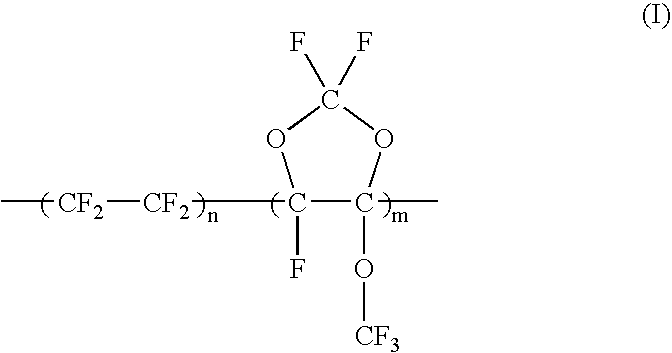Perfluoroelastomer molded article having non-sticking property to metal and method for producing the same
- Summary
- Abstract
- Description
- Claims
- Application Information
AI Technical Summary
Benefits of technology
Problems solved by technology
Method used
Image
Examples
example
[0054] The present invention will be illustrated in greater detail with reference to the following Example, but the invention should not be construed as being limited thereto.
[0055] In a stainless steel autoclave having a volume of 500 ml, 200 ml of distilled water, 2.5 g of ammonium per-fluorooctanoate and 4.4 g of Na2HPO4.12H2O were charged, and then, the inside thereof was replaced by nitrogen gas, followed by pressure reduction. After cooling this autoclave to 50° C., 32 g of tetrafluoroethylene, 68 g of perfluoromethyl vinyl ether and 6.4 g of perfluoro-8-cyano-5-methyl-3,6-dioxa-1-octene were charged therein, and the temperature thereof was elevated to 80° C. Then, 0.75 g of sodium sulfite and 3.75 g of ammonium persulfate were each charged in the form of a 25-ml aqueous solution, and polymerization was initiated. After continuation of the polymerization for 20 hours, an unreacted gas was purged, and an aqueous latex formed therein was taken out. Then, the aqueous latex was s...
PUM
| Property | Measurement | Unit |
|---|---|---|
| Temperature | aaaaa | aaaaa |
| Temperature | aaaaa | aaaaa |
| Temperature | aaaaa | aaaaa |
Abstract
Description
Claims
Application Information
 Login to View More
Login to View More - R&D Engineer
- R&D Manager
- IP Professional
- Industry Leading Data Capabilities
- Powerful AI technology
- Patent DNA Extraction
Browse by: Latest US Patents, China's latest patents, Technical Efficacy Thesaurus, Application Domain, Technology Topic, Popular Technical Reports.
© 2024 PatSnap. All rights reserved.Legal|Privacy policy|Modern Slavery Act Transparency Statement|Sitemap|About US| Contact US: help@patsnap.com








